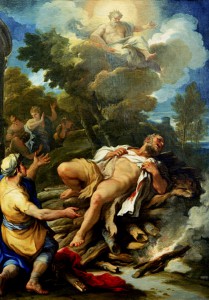
No, those words are not from a mythicist but from a professor of Classics, Arthur Stanley Pease, in an article in the Harvard Studies in Classical Philology, 1942, Vol. 53, pages 1-36 — “Some Aspects of Invisibility“. 1942 may seem like ancient history but the article was referenced more recently in 2010 by Richard C. Miller, an adjunct professor at Chapman University in the Department of Religious Studies, in “Mark’s Empty Tomb and Other Translation Fables in Classical Antiquity” in the Journal of Biblical Literature, Vol. 129, No. 4. More recently still, 2015, Miller has published Resurrection and Reception in Early Christianity which I am looking forward to reading and writing about. (It won’t be for at least some months before I can get to it, unfortunately.) Before I begin on the more recent works, however, I do like to track down their sources and that’s what led me back to 1942. So here we go…..
Noteworthy is the case of Aristeas, a poet and wonder-worker of uncertain date, who, Herodotus tells us, went into a fuller’s shop at Proconnesus on the Propontis and there died. The fuller shut up his shop and went to tell the dead man’s kinsmen, but the report of the death of Aristeas, now noised through the city, was disputed by a man of Cyzicus, who had come from the seaport of Cyzicus and said that he had met Aristeas going toward the town and had spoken with him.
While he so spoke, the kinsmen of the dead man came to the fuller’s shop with all that was needful for the burial, but when the shop was opened no Aristeas was there, either dead or alive.
Seven years later Aristeas appeared at Proconnesus and made that poem which the Greeks later called the Arimaspea, after which he again vanished. (p. 29)
You can read a translation of Herodotus’s account on the Perseus Tufts site.
Pease then refers to a similar story told about Cleomedes by Plutarch in his biography of Romulus. I quote here a translation of Plutarch: Continue reading “The Disappearances of the Bodies of Jesus and Other Heroes”
